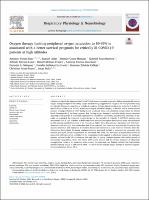Oxygen therapy limiting peripheral oxygen saturation to 89-93% is associated with a better survival prognosis for critically ill Covid-19 patients at high altitudes
Related Resource(s)
https://www.sciencedirect.com/science/article/pii/S1569904822000271?via%3DihubDate
2022-02-08Author(s)
Viruez Soto, Antonio
Arias, Samuel
Casas Mamani, Ronnie
Rada Barrera, Gabriel
Merino Luna, Alfredo
Molano Franco, Daniel
Tinoco Solórzano, Amilcar
Marques, Danuzia A.
Zubieta DeUrioste, Natalia
Zubieta Calleja, Gustavo
Arias Reyes, Christian
Soliz, Jorge
Metadata
Show full item recordAbstract
Patients admitted to the Intensive Care Unit (ICU) with acute hypoxemic respiratory failure automatically receive oxygen therapy to improve inspiratory oxygen fraction (FiO2). Supplemental oxygen is the most prescribed drug for critically ill patients regardless of altitude of residence. In high altitude dwellers (i.e. in La Paz [≈3,400 m] and El Alto [≈4,150 m] in Bolivia), a peripheral oxygen saturation (SatpO2) of 89-95% and an arterial partial pressure of oxygen (PaO2) of 50-67 mmHg (lower as altitude rises), are considered normal values for arterial blood. Consequently, it has been suggested that limiting oxygen therapy to maintain SatpO2 around normoxia may help avoid episodes of hypoxemia, hyperoxemia, intermittent hypoxemia, and ultimately, mortality. In this
study, we evaluated the impact of oxygen therapy on the mortality of critically ill COVID-19 patients who permanently live at high altitudes. A multicenter cross-sectional descriptive observational study was performed on 100 patients admitted to the ICU at the “Clinica Los Andes” (in La Paz city) and “Agramont” and “Del Norte” Hospitals (in El Alto city). Our results show that: 1) as expected, fatal cases were detected only in patients who required intubation and connection to invasive mechanical ventilation as a last resort to overcome their life-threatening desaturation; 2) among intubated patients, prolonged periods in normoxia are associated with
survival, prolonged periods in hypoxemia are associated with death, and time spent in hyperoxemia shows no association with survival or mortality; 3) the oxygenation limits required to effectively support the intubated patients’ survival in the ICU are between 89% and 93%; 4) among intubated patients with similar periods of normoxemic oxygenation, those with better SOFA scores survive; and 5) a lower frequency of observable reoxygenation events is not associated with survival. In conclusion, our findings indicate that high-altitude patients entering an ICU at altitudes of 3,400 – 4,150 m should undergo oxygen therapy to maintain oxygena-
tion levels between 89 and 93 %.
Notes
El Consejo Editorial es un equipo de expertos en el campo de la revista.






